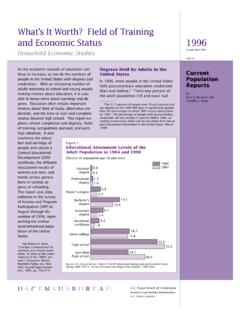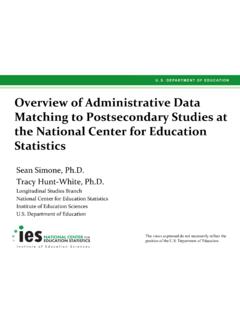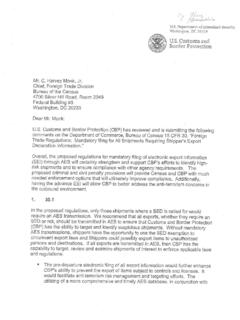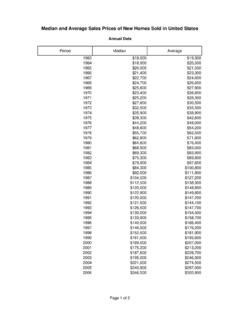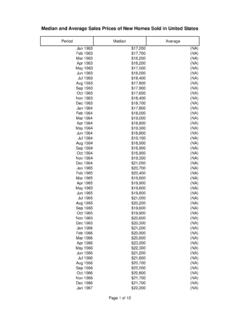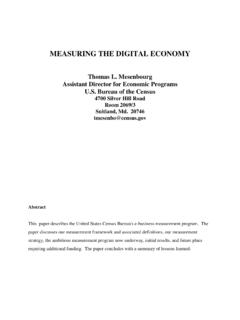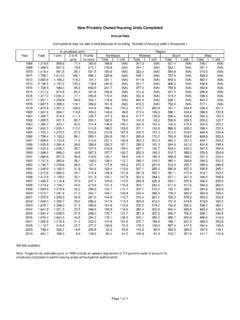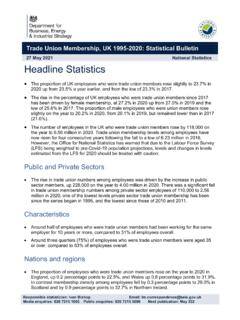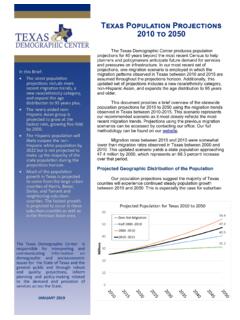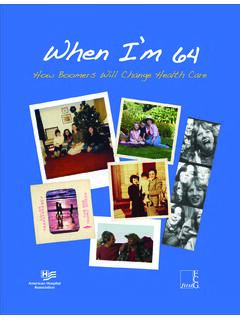Transcription of Demographic Trends in the 20th Century - Census.gov
1 U S C E N S U S B U R E A UDemographic Trends in the 20th CenturyCensus 2000 Special Department of CommerceEconomics and Statistics Administration census BUREAU CENSR-4 Issued November 2002By Frank Hobbs and Nicole StoopsHelping You Make Informed Decisions 1902-2002 This report was prepared by Frank Hobbsand Nicole Stoopsunder the generaldirection of John F. Long, Chief, population Division. Numerous CensusBureau staff contributed to the data compilation, review, and the population Division, Marie Pees, Chief, census Activities and TabulationStaff, provided key information about the availability and comparability ofhistorical census data, as well as census 2000 data tabulations, and ToddGardner, population Distribution Branch, provided significant contributions tothe data compilation and understanding of the metropolitan population data. In the Housing and Household Economic Statistics Division, Leonard J. Norry,Assistant Division Chief, Jeanne Woodward, Chief, Housing Statistics Branch,and William S.
2 Chapin, Housing Statistics Branch, provided similarly vitalcontributions pertaining to the housing thanks are due to Campbell Gibson, population Division, for hiscontributions to multiple phases of the production of this report. He contributedsignificantly to the compilation and understanding of the race and Hispanic-origindata and the households and families data. The authors are especially gratefulfor his thorough review of the whole report and the generous sharing of hisinterest in and his knowledge and breadth of understanding of historical CensusBureau data and Demographic Trends . The authors are grateful to other population Division staff for their contributions tothe verification and review of the data and information contained in this report. Wethank Robert A. Kominski, Assistant Division Chief, Social and DemographicStatistics, for his general direction and review, and Michael Ratcliffe, Chief, population Distribution Branch, Jorge del Pinal, Assistant Division Chief, SpecialPopulations, Annetta Smith, Chief, Age and Sex Statistics Branch, GregorySpencer, Chief, population Projections Branch, Kevin Deardorff, Chief, Ethnic andHispanic Statistics Branch, and Claudette Bennett, Chief, Race Statistics Branch,for their review of specific chapters of the report.
3 We thank Marjorie Hanson, population Division, for the improvements added by her review of the completetext of the report. For verification, the authors thank Donna Defibaugh, Andres Claudio, Marylou Unsell, and Debra Niner, population Division. In the Geography Division, the authors would like to thank the CartographicOperations Branch, including Timothy Trainor, Chief, Constance Beard, TracyCorder, and Deanna Fowlerfor assistance in the geographic representation of thestate population data, and Frederick R. Broomefor assistance with the of population Trends . Greg Carroll, Penny Heiston, Jan Sweeney, Elizabeth J. Williams, and Arlene Butlerof the Administrative and Customer Services Division, Walter , Chief, provided publication and printing management, graphics design, andcomposition and editorial review for print and electronic media. General directionand project management were provided by Gary J. Lauffer, Chief, PublicationServices , the authors wish to thank the many population Division and Housing andHousehold Economic Statistics Division staff, both past and present, whosesubject matter contributions to each decennial census of the 20th Century helpedmake the production of this report Department of CommerceDonald L.
4 Evans,SecretarySamuel W. Bodman,Deputy SecretaryEconomics and Statistics AdministrationKathleen B. Cooper, Under Secretary for Economic census BUREAUC harles Louis Kincannon,DirectorDemographic Trends in the 20th CenturyCENSR-4 Issued November 2002 Suggested CitationHobbs, Frank and Nicole Stoops, census Bureau, census 2000 SpecialReports, Series CENSR-4, Demographic Trends in the 20th Century , Government Printing Office, Washington, DC, STATISTICSADMINISTRATIONE conomics and StatisticsAdministrationKathleen B. Cooper,Under Secretary for Economic census BUREAUC harles Louis Kincannon,DirectorWilliam G. Barron, Jr.,Deputy Director and Chief Operating OfficerPreston Jay Waite,Acting Principal Associate Director for ProgramsNancy M. Gordon,Associate Director for Demographic ProgramsJohn F. Long,Chief, population DivisionFor sale by the Superintendent of Documents, Government Printing OfficeInternet: Phone: toll free 866-512-1800; DC area 202-512-1800 Fax: 202-512-2250 Mail: Stop SSOP, Washington, DC census BureauDemographic Trends in the 20th Century iiiHighlights.
5 1 Introduction .. Size and Geographic Distribution .. and Sex Composition .. and Hispanic Origin ..137 Text Table1-1. States Experiencing Intercensal population Decline: 1900-1910 to 1990-2000 ..251-2. States Ranked by population Size: 1900, 1950, and 2000 ..291-3. Ten Most Populous Metropolitan Areas: 1950 to 2000 ..372-1. Ten States With the Highest Percents Under Age 15 and Age 65 and Over: 1900, 1950, and 2000 ..613-1. Ten States With the Highest Percents Black, American Indian and Alaska Native, and Asian and Pacific Islander: 1900, 1950, and 2000 ..93 Figure1-1. Total population : 1900 to 2000 ..111-2. population Increase by Decade: 1900 to 2000 ..131-3. World population Distribution: 1950 to 2000 ..141-4. population Density: 1900 to 2000 ..151-5. Mean and Median Centers of population : 1900 to 2000 ..171-6. Total population by Region: 1900 to 2000 ..191-7. population Distribution by Region: 1900 to 2000.
6 191-8. Percent Change in population per Decade by Region: 1900 to 2000 ..201-9. population Density by Region: 1900 to 2000 ..211-10. Total population by State: 1900, 1950, and 2000 ..231-11. Increase in Total population by State: 1900-2000 ..241-12. Percent Change in Total population by State: 1900-1950 and 1950-2000 ..271-13. population Density by State: 1900, 1950, and 2000 ..311-14. Total population by Metropolitan Status: 1910 to 2000 ..321-15. Percent of Total population Living in Metropolitan Areas and in Their Central Cities and Suburbs: 1910 to 2000 ..33 Table of ContentsivDemographic Trends in the 20th census Bureau1-16. Percent of Total population Living in Metropolitan Areas by Size of Metropolitan Area population : 1950 to 2000 ..351-17. population Density by Metropolitan Area Status: 1950 to 2000 ..391-18. Percent of population Living in Metropolitan Areas by Region: 1910 to 2000 ..411-19. Percent of population Living in Metropolitan Areas by State: 1910, 1950, and 2000.
7 431-20. Percent of Total population Living in the Ten Largest Cities: 1900 to 2000 ..452-1. Total population by Age and Sex: 1900, 1950, and 2000 ..532-2. Age and Sex Distribution of the Total population : 1900, 1950, and 2000 ..542-3. Total population by Broad Age Group: 1900 to 2000 ..552-4. Percent Distribution of the Total population by Age: 1900 to 2000 ..562-5. Median Age: 1900 to 2000 ..572-6. population Age 65 and Over: 1900 to 2000 ..592-7. Percent of Total population Age 65 and Over: 1900 to 2000 ..592-8. Percent Under Age 15 and Percent Age 65 and Over by Region: 1900 to 2000 ..602-9. Sex Ratio: 1900 to 2000 ..622-10. Sex Ratio by Region: 1900 to 2000 ..632-11. Sex Ratio by State: 1900, 1950, and 2000 ..652-12. Sex Ratio by Metropolitan Area Status: 1950 to 2000 ..662-13. Sex Ratio by Broad Age Group: 1900 to 2000 ..673-1. Total population by Race: 1900 to 2000 ..753-2. population of Races Other Than White or Black by Race: 1900 to 2000.
8 753-3. Distribution of Total population by Race: 1900 to 2000 ..773-4. Percent Races Other Than White or Black by Race: 1900 to 2000 ..773-5. Hispanic population and Percent Hispanic of Total population : 1980 to 2000 ..783-6. Average Annual Growth Rate by Race: 1900-1950, 1950-2000, and 1900-2000 ..793-7. Percent Change in population Size by Race and Hispanic Origin: 1980-2000 ..813-8. Regional Distribution of Total population by Race: 1900 to 2000 ..833-9. Percent Races Other Than White by Race and Region: 1900 to 2000 ..853-10. Hispanic population Distribution by Region: 1980 to 2000 ..873-11. Percent Hispanic of Regional population : 1980 to 2000 ..873-12. Percent Minority by Region: 1980 to 2000 ..893-13. Percent Races Other Than White by State: 1900, 1950, and 2000 ..913-14. Percent Two or More Races by State: 2000 ..953-15. Percent Hispanic by State: 1980 and 2000 ..973-16. Percent Minority by State: 1980 and 2000.
9 993-17. Percent Metropolitan by Race and Hispanic Origin: 1960 to 2000 .. 1013-18. Age and Sex Distribution of the Total population by Race: 1900, 1950, and 2000 .. 1033-19. Age and Sex Distribution of the Total population by Hispanic Origin: 1980 and 2000 .. 1053-20. Median Age by Race and Hispanic Origin: 1900 to 2000 .. 1063-21. Percent Minority by Broad Age Group: 1980 to 2000 .. 1073-22. Percent Under Age 15 by Race and Hispanic Origin: 1900 to 2000 .. census BureauDemographic Trends in the 20th Century v3-23. Percent Age 65 and Over by Race and Hispanic Origin: 1900 to 2000 .. 1093-24. Sex Ratio by Race and Hispanic Origin: 1900 to 2000 .. 1114-1. Total Housing Units by Occupancy Status: 1940 to 2000 .. 1194-2. Distribution of Total Housing Units by Occupancy Status: 1940 to 2000 .. 1194-3. Vacancy Rate by Region: 1940 to 2000 .. 1214-4. Vacancy Rate by State: 1940 and 2000 .. 1234-5.
10 Occupied Housing Units by Tenure: 1900 to 2000 .. 1254-6. Distribution of Occupied Housing Units by Tenure: 1900 to 2000 .. 1254-7. Percent Owner-Occupied Housing Units by Region: 1900 to 2000 .. 1274-8. Percent Owner-Occupied Housing Units by State: 1900, 1950, and 2000 .. 1294-9. Percent Owner-Occupied Housing Units by Metropolitan Status: 1960 to 2000 .. 1304-10. Homeownership Rate by Age of Householder: 1960 to 2000 .. 1314-11. Homeownership Rate by Race and Hispanic Origin of Householder: 1980 and 2000 .. 1324-12. Homeownership Rate by Household Size: 1940 to 2000 .. 1335-1. Households by Size: 1900 and 1940 to 2000 .. 1415-2. Distribution of Households by Size: 1900 and 1940 to 2000 .. 1415-3. Average Household Size: 1900 and 1930 to 2000 .. 1435-4. Total Households by Region: 1900 to 2000 .. 1455-5. Distribution of Households by Region: 1900 to 2000 .. 1455-6. Total Households by Age of Householder: 1950 to 2000.
